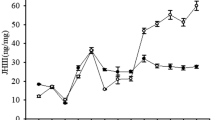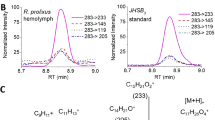Summary
Larvae of the beetleDendroides canadensis accumulate protein antifreezes during the winter.D. canadensis which were collected in the early fall, prior to the initiation of cold hardening processes, were treated with either 3.3 or 6.6 μg juvenile hormone I topically in acetone and maintained for 21 days under normally non-inductive acclimation conditions (16 light/8 dark, 20 °C). Hormone treated animals significantly elevated the levels of antifreeze protein in their hemolymph compared to those of acetone treated and untreated controls or animals measured on the day of collection.
D. canadensis treated with the anti-JH compound precocene II (P2) in acetone for 24 h at a concentration of 20 μg/cm2 (a dose below LD50 for ‘behavioral’ survival) and then maintained under acclimation conditions conducive to antifreeze protein production (8 light/16 dark, 20 °C) for 2 weeks failed to elevate levels of antifreeze. Acetone treated control animals accumulated a significant concentration of antifreeze protein.D. canadensis were also treated with 20 and 150 μg/cm2 P2 (a dose below the LD50 for ‘gross’ survival) followed by acclimation to short (8 h) photoperiod at 10 °C. All animals receiving the higher P2 dosage failed to elevate antifreezes while only 42.9% of the individuals treated with the lower dosage initiated antifreeze protein production. In contrast, over 80% of untreated and 70% of acetone treated controls responded to these inductive acclimation conditions by elevating antifreeze concentrations.
These results indicate that juvenile hormone participates in the seasonal control of antifreeze protein production inDendroides canadensis. Since this species does not enter a diapause state prior to or throughout the winter this is the first evidence establishing a direct hormonal mechanism involved with insect cold hardiness.
Similar content being viewed by others
References
Baust JG, Miller K (1970) Variations in glycerol content and its influence on cold hardiness in the Alaskan carabid beetlePterostichus brevicornis. J Insect Physiol 16:979–990
Beck SD (1980) Insect photoperiodism, 2nd edn. Academic Press, New York
Bowers WS (1981) How anti-juvenile hormones work. Am Zool 21:737–742
Bowers WS, Ohta T, Cleare JS, Marsella PA (1976) Discovery of insect anti-juvenile hormones in plants. Science 193:542–547
Brown JJ, Chippendale GM (1978) Juvenile hormone and a protein associated with the larval diapause of the southwestern corn borerDiatraea grandiosella. Insect Biochem 8:359–367
Chino H (1958) Carbohydrate metabolism in the diapause egg of the silkworm,Bombyx mori. Conversion of glycogen into sorbitol and glycerol during diapause. J Insect Physiol 2:1–12
Chippendale GM (1977) Hormonal regulation of larval diapause. Annu Rev Entomol 22:121–138
Duman JG (1977a) Environmental effects on antifreeze levels in larvae of the darkling beetle,Meracantha contracta. J Exp Zool 210:333–337
Duman JG (1977b) The role of macromolecular antifreezes in the darkling beetle,Meracantha contracta. J Comp Physiol 115:279–286
Duman JG (1980) Factors involved in the overwintering survival of the freeze tolerant beetleDendroides canadensis. J Comp Physiol 136:53–59
Fukuda S (1963) Determinisme hormonal de la diapause chez le ver à soie. Bull Soc Zool (Fr) 88:151–179
Gibbs D (1975) Reversal of pupal diapause inSarcophaga argyrostoma by temperature shifts after puparium formation. J Insect Physiol 21:1179–1186
Horwath KL, Duman JG (1982) Involvement of the circadian system in photoperiodic regulation of insect antifreeze proteins. J Exp Zool 219:267–270
Horwath KL, Duman JG (1983) Preparatory adaptations for winter survival in the cold hardy beetles,Dendroides canadensis andDendroides concolor. J Comp Physiol 151:225–232
Kelly T, Fuchs MS (1978) Precocene is not a specific antigonadotropic agent in adult femaleAedes aegypti. Physiol Entomol 3:297–302
Mansingh A (1971) Physiological classification of dormancies in insects. Can Entomol 103:983–1009
Masner P, Bowers WS, Kalin M, Muhle T (1979) Effect of precocene II on the endocrine regulation of development and reproduction in the bug,Oncopeltus fasciatus. Gen Comp Endocrinol 37:156–166
Müller HJ (1970) Formen der Dormanz bei Insekten. Nova Acta Leopold 35:1–27
Nair KS (1974) Studies on the diapause ofTrogoderma granarium. Effects of juvenile hormone analogues on growth and metamorphosis. J Insect Physiol 20:231–244
Patterson JL, Duman JG (1982) Purification and composition of protein antifreezes with high cysteine contents from larvae of the beetle,Tenebrio molitor. J Exp Zool 219:381–384
Perkins HF, Aranoff S (1959) A paper chromatographic method for the purification of shikimic acid-U-C14 obtained from culture filtrates of a mutant ofEscherichia coli. Can J Biochem Phys 37:149–150
Ramsay JA, Brown RH (1955) Simplified apparatus and procedure for freezing point deteminations upon small volumes of fluids. J Sci Instrum 32:372–375
Ring RA, Tesar D (1981) Adaptations to cold in Canadian Arctic insects. Cryobiology 18:199–211
Salt RW (1957) Natural occurrence of glycerol in insects and its relation to their ability to survive freezing. Can Entomol 89:491–494
Salt RW (1961) Principles of insect cold hardiness. Ann Rev Entomol 6:55–74
Saunders DS (1971) The temperature compensated photoperiodic clock ‘programming’ development and pupal diapause in the flesh-flySarcophaga argyrostoma. J Insect Physiol 17:801–812
Saunders DS (1980) Some effects of constant temperature and photoperiod on the diapause response of the flesh-fly,Sarcophaga argyrostoma. Physiol Entomol 5:191–198
Sömme L (1964) Effects of glycerol on cold hardiness in insects. Can J Zool 42:87–101
Takeda M, Chippendale GM (1982) Environmental and genetic control of the larval diapause of the southwestern corn borerDiatraea grandiosella. Physiol Entomol 7:99–110
Truman JW (1972) Physiology of insect rhythms I: Circadian organization of the endocrine events underlying the molting cycle of larval tobacco hornworms. J Exp Biol 57:805–820
Truman JW, Riddiford L (1970) Neuroendocrine control of ecdysis in silkmoths. Science 167:1624–1626
Truman JW, Riddiford L (1974) Physiology of insect rhythms III: The temporal organization of the endocrine events underlying pupation of the tobacco hornworm. J Exp Biol 60:371–382
Turunen S, Chippendale GM (1980) Proteins of the fat body of nondiapausing and diapausing larvae of the southwestern corn borerDiatraea grandiosella. Effect of juvenile hormone. J Insect Physiol 26:163–169
Unnithan GC, Nair KK (1979) Influence of corpus allatum activity on the susceptibility ofOncopeltus fasciatus, to precocene. Ann Entomol Soc Am 72:38–40
Yaginuma T, Yamashita O (1978) Polyol metabolism related to diapause inBombyx eggs: Different behavior of sorbitol from glycerol during diapause and post diapause. J Insect Physiol 24:347–354
Yin CM, Chippendale GM (1973) Juvenile hormone regulation of larval diapause of the southwestern corn borerDiatraea grandiosella. J Insect Physiol 19:2403–2420
Yin CM, Chippendale GM (1979) Diapause of the southwestern corn borer,Diatraea grandiosella. Further evidence showing juvenile hormone to be the regulator. J Insect Physiol 25:513–523
Young SR, Block W (1980) Experimental studies on the cold tolerance ofAlaskozetes antarcticus. J Insect Physiol 26:189–200
Ziegler R, Wyatt GR (1975) Phosphorylase and glycerol production activated by cold in diapausing silkmoth pupae. Nature 254:602–603
Author information
Authors and Affiliations
Rights and permissions
About this article
Cite this article
Horwath, K.L., Duman, J.G. Induction of antifreeze protein production by juvenile hormone in larvae of the beetle,Dendroides canadensis . J Comp Physiol B 151, 233–240 (1983). https://doi.org/10.1007/BF00689923
Accepted:
Issue Date:
DOI: https://doi.org/10.1007/BF00689923




